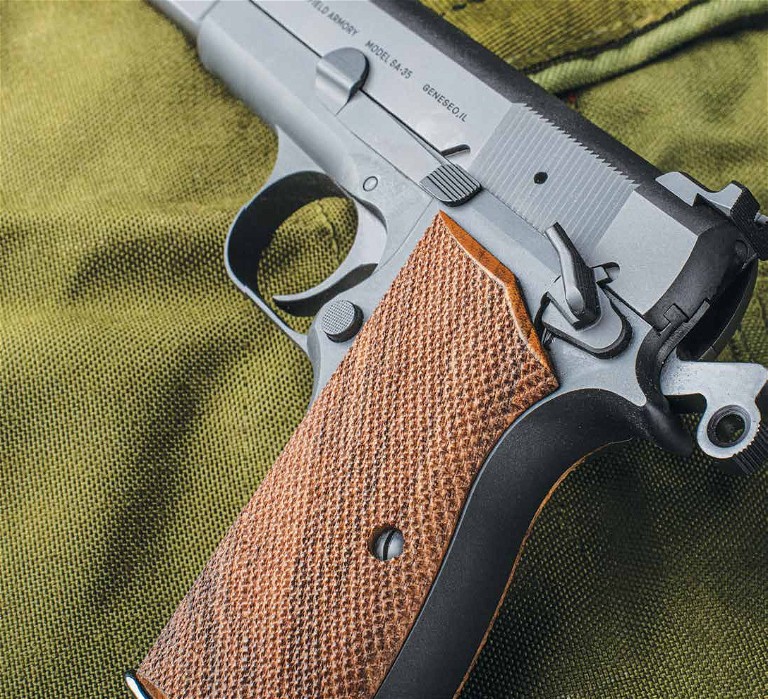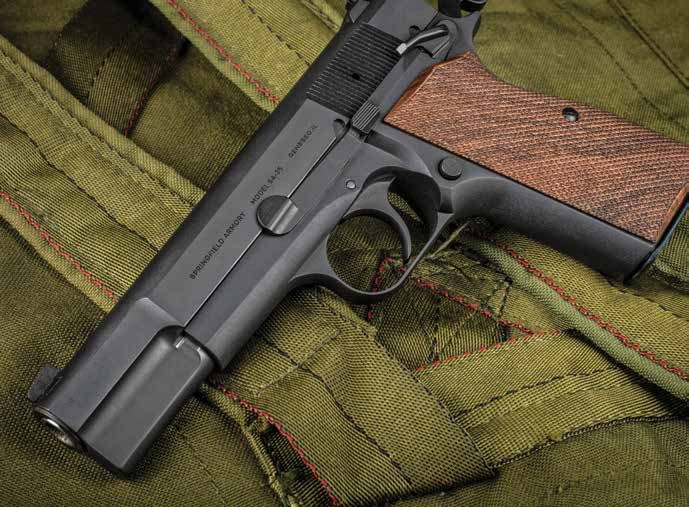BOB CAMPBELL
FAITHFUL TO THE HI POWER
SPRINGFIELD ARMORY SA-35

A TRIUMPHANT RETURN
Shooters who’ve been seeking a newin-box 9mm Hi Power can finally scratch that itch — and it’s American-made too.
We have to credit Dieudonné Saive with finishing the Hi Power’s design a little less than a decade after John Moses Browning’s death. Since its release in 1935, more than a million FN Herstal Hi Powers have been procured for military use by more than 50 countries. After nearly a 90-year run, FN discontinued the renowned pistol in 2018. But in 2021, Springfield introduced the SA-35, a modern version of the Hi Power, which has great promise both for commercial success and as a personal-defense handgun.
THE HI POWER’S ALLURE
FN Herstal discontinued the Hi Power because it had not been a good seller for many years (perhaps, in part, because its MSRP rose to well over $1,000). There have been quality copies, including the Argentine FM and the Tisas, but neither is readily available. And used FN and Browning models command high prices, so getting hands on a shooter-grade pistol can be difficult
This is not without good reason. The Hi Power is a well-made pistol with good fitting of the barrel, receiver and slide, and its historical significance in conflicts worldwide makes it appealing to collectors. I have seen heavily worn examples but never a Hi Power with a factory defect. One flaw is that the safety in most renditions is too small for rapid manipulation, but late-model versions remedied this by including a larger safety that affords greater purchase. With such a modification, the speed to an accurate first shot is unrivaled. Combine that with the fact that the Hi Power has proven to be one of the most reliable handguns out there and you’ve got a recipe for an in-demand pistol.

SAFETY FIRST
As with the 1911, the SA-35 should be carried “cocked and locked” — hammer back, safety on. Never attempt to lower the hammer to halfcock over a live round.
PICKY EATER?
Whenever a military pistol makes its way into private-citizen hands, the topic of its performance with jacketed hollow-points always pops up. I have fired Second World War Hi Power variants that are completely functional with modern hollow-points. Yes, the Hi Power at one time was criticized for poor reliability with JHPs, but this had more to do with the short 90-grain “Super Vel” rounds and inferior ammunition branded for a major pistol maker than any other attribute of the handgun. With Remington’s JHP, Federal’s 9B and Winchester’s Silvertip, I never experienced a stoppage. Modern loads from Black Hills, Hornady, the Big Three and Speer are reliable in any 9mm handgun.
In all fairness, the Hi Power trigger was seldom very good and was tricky to address, which made for a difficult combination. The sights and safety were too small (save the MKII version). When properly set up, the pistol is a joy to use and fire and is a formidable handgun in every way, but the key there is “when properly set up.” Opening the box was the beginning of the job, not the end.
ENTER SPRINGFIELD
Springfield Armory has produced the 1911A1 handgun and M1A rifle for many years, both of which have enjoyed an enviable record for reliability and value. So it is no surprise that the SA-35 — Springfield’s take on the Hi Power — is a quality product.
The pistol is a single-action handgun, meaning the hammer is cocked as the slide is racked. The user must carry the pistol with the hammer to the rear and the safety on for personal-defense readiness.
A longtime home-ready mode is hammer down on a loaded chamber, but this involves intentionally lowering a pistol’s hammer on a live round when you do not intend to fire, which is about as unsafe as it sounds — especially when you consider practitioners of this technique are basically never doing so on a firing line but rather in their residences. Carry your single-action pistol as it should be carried: cocked and locked, all safeties engaged, and in a proper holster. No carry condition is safer.
The Springfield SA-35 looks like and operates in an identical fashion to the FN Hi Power. The slide and frame contours are the same. The Hi Power is similar to the earlier Browning-designed 1911 but with no separate barrel bushing, swinging link or grip safety, which makes it simpler to manufacture than the 1911. The trigger action is more difficult to tune than a 1911’s, but it can be accomplished. The new SA-35 gets a nod of approval on faithful design.
The pistol is all steel — as a Hi Power should be — and it has a matte-blued finish similar in appearance to Springfield’s “Mil-Spec” pistols, with grips of nicely checkered walnut. The barrel, slide and frame are forged, which ensures strength and durability. (Late-model FN Hi Power pistols used a cast frame, which works fine, but forged steel is superior.) The SA-35’s lockwork is free of metal injection molding (MIM) parts.
BOB REESE AND SPRINGFIELD ARMORY, INC.
■ Robert Rost Reese, a veteran of the National Guard, took up farming after being discharged in the 1950s. But Reese’s real passion was competitive shooting and guns. He bought surplus firearms from the government arsenal in Rock Island, Illinois, and began to resell them. He took a leap of faith when he took a mortgage out on the farm and acquired a surplus company based in San Antonio, Texas. He loaded two semi-truck trailers with equipment and drove them back to Geneseo, Illinois. Reese; his wife, Carol; and their sons, Dennis, Dave and Tom, established Springfield Armory, Inc. in 1974. He chose to name his company after the famous armory that closed in 1968 after over 150 years of supplying arms to the U.S. Army. The Reeses set up their new business at a former diner and began building M1A rifles from the surplus M14 parts. Fast forward to 2022 and the company now manufacturers high-quality firearms, such as the 1911, SA-35, XD, Hellcat, SAINT AR-15 and more. In April 2021, the company announced it would break ground on a new 200,000-square-foot facility. Reese passed away in 2019, but his son Dennis currently serves as CEO.
— Frank Jastrzembski, Contributing Editor
It would be beyond understatement to say that the modern sight configuration is an improvement over the original. The front sight is a dovetail post, and the “Tactical Rack” rear sight is a considerable improvement over even the late-model Browning MKII-type sights and may be used to rack the slide on a sturdy belt or boot heel. The wedge-type unit uses a U-notch, which makes for rapid acquisition of the sight picture and is the ideal combination for personal-defense use.
The pistol may be fitted with aftermarket grips intended for the original Hi Power, and Hi Power holsters are the same for every Hi Power, including the SA-35. Original Hi Power magazines lock and function as they should, but the Springfield-designed magazines hold 15 rounds rather than the original 13. The mags are manufactured by Mec-Gar, which translates to fit, finish and function.
The extended thumb safety isn’t the size of a gas pedal, but it is much improved over the original and even the MKII types, and the indent is positive. The hammer isn’t quite true to the Hi Power design, but this is a positive, as the improved geometry prevents “hammer bite” on the web of the hand.
The majority of Browning Hi Powers feature a magazine safety — unless it was specifically removed to meet contract requirements — which will not allow them to fire without a magazine inserted and seated. Such a safety sometimes interfered with a good trigger pull. The SA-35 has no such device, and the trigger is among the best I have experienced, breaking at a relatively clean 4.9 pounds.
TO THE LINE
Though a 34-ounce 9mm doesn’t kick much, the SA-35 seems to recoil more than the polymer-frame guns. That is simply the nature of the beast. However, it will be more accurate in fast combat shooting in trained hands.
Before I received the pistol, I ordered a Bullard Leather IWB holster for this assessment. I carried the pistol under a concealed carry vest during the initial drills, and it cleared leather quickly and got on target fast. It balances well and doesn’t have the heft of the 1911 or the blocky feel in hand of a Glock. Draw, push the pistol toward the target, and engage. I was able to remove the X-ring at 7 yards with the sample I evaluated.
I alternated 124- and 147-grain Federal American Eagle loads during the test with no problems on either end of the spectrum. The pistol never failed to feed, chamber, fire or eject, and loading the SA-35 magazine and several Mec-Gar magazines on hand wasn’t difficult.
The advantage of the SA-35 is partly due to excellent hand fit to a wide swath of the shooting public’s hands and the crisp, straight-to-the-rear trigger action. Between that and the fact that this pistol is carried cocked and locked, with only a thumb safety that must be disengaged before firing, it is brilliantly fast to an accurate first shot. The cavernous mag well and tapered magazine make magazine changes fast and easy, and all of this combines to leave the Hi Power with few peers in the hands of a trained shooter.
To test for absolute accuracy, I settled into the MTM Case Gard K-Zone shooting rest, which is a fine piece of gear that removes a great deal of human error and allows a trained shooter to discharge firearms right up to their true potential. I tested three loads at 25 yards with five-shot groups — Federal 124-grain HST, Federal 124-grain American Eagle and Speer 147-grain Gold Dot — and accuracy was consistent, with the Speer load cutting a 2.25-inch group, the American Eagle load a 2.5-inch group and the HST a very nice 2-inch average. This is accurate enough for any chore.
REIMAGINED FOR MODERN USE
Cutting-edge manufacturing techniques and technology are incorporated in this classic design. Though some were likely skeptical at first blush, Hi Power aficionados will be pleased with the SA-35. And so will new shooters who desire to have a piece of history that is still practical to carry nearly 90 years after it was first introduced.
SOURCES
Bullard Leather: BullardLeather.com
Mec-Gar: Mec-Gar.com
Springfield Armory: Springfield-Armory.com